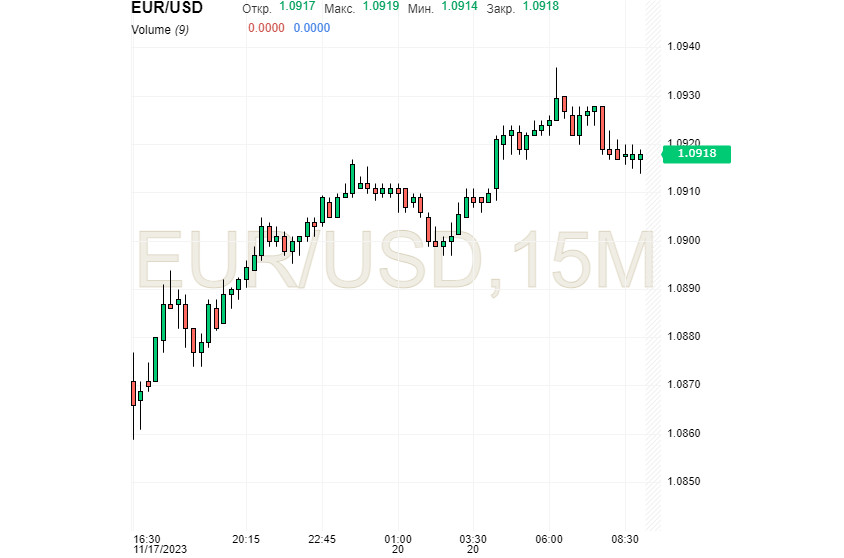
Last week, the greenback slumped against the euro. The US currency experienced its second sharpest weekly decline in 2023 compared to other major currencies. Weak US inflation data released last week fueled market expectations of an imminent Federal Reserve rate cut. However, experts warn that this is unlikely. Nevertheless, many traders factored in the first Fed rate cut in the first quarter of 2024. This undermines the dollar, which had been rising confidently from July to October 2023, anticipating that the regulator had not yet reached the peak of rate hikes.
However, after the release of disappointing US macroeconomic reports, expectations for a tightening of Fed policy suffered a setback. Meanwhile, many investors priced in aggressive rate cuts next year.
Traders were previously anxious when ambiguous economic indicators followed the US Consumer Price Index report. The recent spike in weekly US unemployment claims is considered a strong indicator of further economic growth in the US. As for the disappointing industrial production figures, they confirm the view that the US economy is cooling.
Notably, during the week ending November 10, US initial unemployment claims soared to 231,000, exceeding the forecast of 220,000. As for industrial production, the figure for October fell short of expectations, decreasing by 0.3% year-over-year and 0.6% month-over-month. These unfavorable economic reports spurred a decrease in US Treasury bond rates, leading to a jump in prices. Consequently, the yield on 2-year bonds plummeted to 4.83%, while yields on five-year and ten-year bonds fell to 4.43% and 4.45%, respectively.
Nevertheless, some Federal Reserve officials remain optimistic. According to Susan Collins, head of the Federal Reserve Bank of Boston, current financial conditions continue to be favorable for the regulator. She also considers the latest US Consumer Price Index data promising. However, the politician cautions against premature euphoria and declarations of victory over high inflation. She does not rule out the possibility of further tightening.
Under the current conditions, reports showing a slight increase in US housing construction supported the US dollar. However, rising inflation continues to weigh on the greenback, capping its confident ascent. Bipan Rai, North America head of FX strategy at CIBC Capital Markets, supposes that the latest data from the US indicates progress in addressing inflation. However, the initial momentum gained after the publication is now directed towards a decrease in the USD.
Sean Osborne, the chief currency strategist at Scotiabank, believes the recent rebound in the greenback is favorable for selling. The analyst is confident that a recovery of the US dollar is still possible, especially considering the increased risk of volatility towards the year's end. Against this backdrop, many experts anticipate that the growth rate of the US economy will slow down in the fourth quarter of 2023.
In this light, the euro may continue to gain in value. Notably, at the end of the last week, it advanced by 0.52%, surpassing an important level of 1.0900 and reaching 1.0906. The euro's surge occurred after Eurostat published its data, confirming that annual inflation in the eurozone sharply decelerated in October. At the beginning of the new week, the euro's upward trend gained momentum. On Monday, November 20, the EUR/USD pair hovered around 1.0918, attempting to climb higher.

This week, markets are focusing on important macroeconomic data set to be released on Thursday, November 23. These are the initial PMI estimates for November for the eurozone and the US. In Europe, the indicator is likely to rise, as the IFO and ZEW business sentiment indices previously showed improvement, and the IFO Institute noted that Germany coped with the worst period. Experts suggest that a significant improvement in the eurozone's PMI indices could push the EUR/USD pair to new highs.
Meanwhile, current reports on the US dollar index (USDX) indicate growing bullish sentiment for the American currency. Last week, traders actively reduced both selling and buying of the USD. This led to a slight increase in the net position for the growth of the greenback, with the net position of major market players reaching a high not seen in the last 11 months. Analysts assert that this strengthening trend contributes to the rise of the US currency.
Specialists note that key data from most global economies raised concerns about economic prospects. However, analysts are confident that central banks are capable of winning the battle against rising prices. Despite the slowdown in the US economy, other major economies are either stagnating or in a recession.
Against this backdrop, markets are pricing in a 93-basis-point reduction in the Federal Reserve's overnight lending rate by December 2024. Such a scenario favors the weakening of the US currency.
Furthermore, financial markets anticipate a 100-basis-point rate reduction in the eurozone next year. However, the situation could change at any moment, as some ECB policymakers warn. Notably, ECB officials Robert Holzmann and Joachim Nagel have stated the agency's readiness to raise interest rates again if necessary.
 English
English 
 Русский
Русский Bahasa Indonesia
Bahasa Indonesia Bahasa Malay
Bahasa Malay ไทย
ไทย Español
Español Deutsch
Deutsch Български
Български Français
Français Tiếng Việt
Tiếng Việt 中文
中文 বাংলা
বাংলা हिन्दी
हिन्दी Čeština
Čeština Українська
Українська Română
Română

